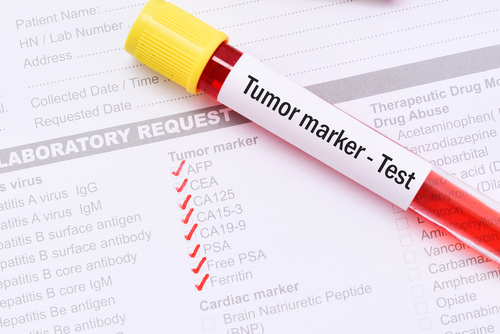A blood test measuring levels of the protein cancer antigen 125 (CA125) can help detect ovarian cancer in a primary care setting with considerable accuracy, a study reported.
The research also showed for a first time that this test can also help in identifying other cancer types, particularly in women ages 50 and older.
The study, “The diagnostic performance of CA125 for the detection of ovarian and non-ovarian cancer in primary care: A population-based cohort study,” was published in PLOS Medicine.
A timely diagnosis is critical for effective cancer management. Across cancer types, treatment outcomes are usually better when tumors are diagnosed at early stages, before they have grown or spread in the body.
“Earlier detection and diagnosis of cancer offers the single biggest opportunity to save lives from the disease,” Jodie Moffat, PhD, Cancer Research UK‘s head of early diagnosis, said in a press release.
Ovarian cancer is often not diagnosed until symptoms cause a patient to seek guidance from a healthcare provider. But the symptoms of ovarian cancer — such as abdominal pain, bloating, frequent urination, and fatigue — are also common symptoms to other conditions, which can make a diagnosis difficult.
CA125 is typically elevated in the blood of people with ovarian cancer, and it is already widely used to aid in ovarian cancer diagnoses.
Commonly, the first exam after symptom onset is performed in a doctor’s office (primary care setting) by a general practitioner (GP). But, while the efficacy of CA125 diagnostic testing for ovarian cancer in specialty settings is established, there’s little published data concerning its use in primary care settings.
Researchers in the U.K. analyzed data from national databases, identifying 50,780 women who underwent CA125 testing between 2011 and 2014. Using statistical models, they compared CA125 levels recorded with the likelihood of a cancer diagnosis over the year that followed the test.
In total, 456 (0.9%) of these people developed ovarian cancer, and 1,321 (2.6%) developed other types of cancer (e.g., lung or pancreatic cancer).
In the U.K., a CA125 value of 35 units/mL is widely used as a cutoff for ovarian cancer risk. The positive predictive value (PPV) of CA125 based on this cutoff — that is, the proportion of people with a value of 35 units/mL or higher who indeed had ovarian cancer — was 10.1%. Its negative predictive value (NPV) — the proportion with a test below that cutoff, signaling no cancer, who indeed did not have ovarian cancer — was 99.8%.
Using the same 35 units/mL cutoff, the PPV for non-ovarian cancers was 12.3%, and the PPV for all cancers — ovarian and non-ovarian — was 21.2%. This meant that about one-fifth of women testing positive in this test ended up having a cancer.
Notably, this proportion was higher for people ages 50 or older, compared with younger individuals, for ovarian cancer (15.2% vs. 3.4%) as well as non-ovarian cancer (20.4% vs. 2.8%).
While CA125 is a well-established marker of ovarian cancer, its usefulness as a diagnostic marker in other cancer types isn’t clear.
“CA125 is unlikely to be a useful test for the detection of individual types of non-ovarian cancer in primary care, most of which have superior triage tests,” the researchers wrote. “However, given our study findings, a high CA125 level in a woman [50 years old or older] should raise a suspicion of non-ovarian cancer.”
Doctors “should consider alternative cancers particularly when ovarian cancer has been excluded,” they added.
In subsequent analyses, the researchers calculated the cut-off value that would be needed to reach a 3% probability of cancer. Overall, a CA125 level of 53 units/mL equated to a probability of 3% for ovarian cancer, while a CA125 level of 18 units/mL equated to a probability of 3% for all cancer types.
The 3% cutoff for ovarian cancer risk varied markedly with age: from 104 units/mL in 40-year-olds, to 32 units/mL in 70-year-olds.
“This blood test is clearly a useful tool for detecting ovarian cancer in primary care, particularly for women aged 50 or more,” said Fiona Walter, MD, a study co-author and professor at the University of Cambridge.
“Our results will help doctors triage women of different ages, selecting those with a higher risk of having cancer for fast referral and further tests,” Walter added. “We hope that using the test, in this way, will help diagnose women with cancer earlier, while reducing unnecessary worry in those without the disease.”
Moffat, who was not directly involved in the study, added: “This research reinforces the value of a readily available test. We encourage GPs to use the CA125 test readily … [and] urge anyone who has noticed a change in their health to contact their GP, get their symptoms checked and attend any tests their doctor thinks are needed.”

